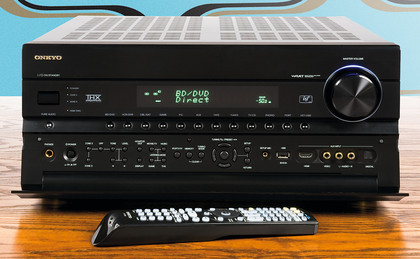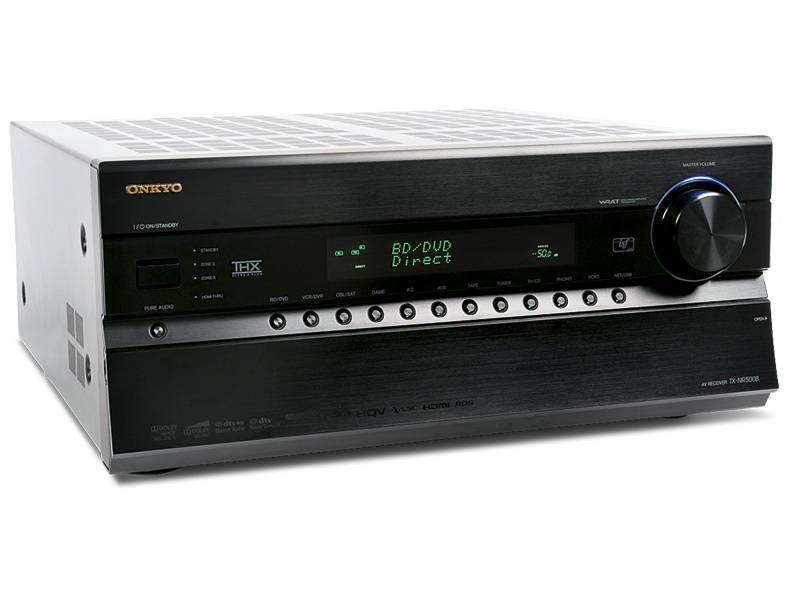Why you can trust TechRadar
Setting up shop
Room calibration is achieved via a small supplied pyramid mic, using Audyssey 2EQ algorithms. In my experience, these systems tend to have unpredictable results, but are usually worth a shot. The AVR pulses out test tones so that the room response can be analysed. The number crunching employed here is actually very good.
The Audyssey system ironed out some lumpy mid-bass introduced by my listening room to give a better overall balance. I still felt the urge to tweak (the LFE output was too low for starters), but generally I felt the calibration effort provided a good starting point.
Codec support is class leading. In addition to Dolby TrueHD and DTS-HD Master Audio, there's Dolby Pro-Logic IIz, which creates a seven-channel soundstage from any stereo source. There is also plenty of DSP, plus extra height/ width processing options in the form of Audyssey DSX and Dolby Pro-logic IIz.
Personally, I can't get too het up over height channels – at least not hard-wired ones. I suspect for the vast majority, they are just too problematic to implement; the front heights need to be placed about 100cm above the main stereo pair to be effective. My listening room just doesn't have that kind of ceiling height (users of smaller standmount L/C/Rs might have more options). Unless it's possible to extend the soundfield virtually, I'm not inclined to experiment.
Audyssey's DSX width processing is more intriguing. It's based on the premise that an extremely wide front soundstage with two rears is more immersive and realistic than you'll get from a conventional 7.1 system with four surrounds. Whatever configuration you prefer, there are plenty of options you can deploy.
With the NR5008 sporting nine channels of amplification, you can even have your cake and eat it, running extra height and width plus side and rear back channels (9.2). For the bulk of my audition I ran the receiver in a 7.2 format.
The NR5008 is undeniably versatile. If you don't want to fill your living room with loudspeakers, you could choose to run 5.1 multichannel in your main room and stereo in two other zones.
I'm not sure that too many UK enthusiasts have needed multiroom audio from an AVR (our homes are just not as big as those in the US) and looking ahead, wireless solutions such as Air Play seem a far more sensible option if the concept floats your boat.
Curiously, Air Play is not part of this Onkyo's arsenal. Are we seeing the brand slip behind some of its rivals for the first time in years, when it comes to introducing technical innovations?
THX and beyond
Half the fun of any listening session with the NR5008 involves juggling sound modes.
Of course, there is the usual selection of DSPs available, the best of which are Orchestra (which emphasises the surround channels and adds extra reverb), Unplugged (which does the reverse and stresses front stereo) and All Channel Stereo (basically a full-on party mix).
The unit is THX Ultra2 certified, and courtesy of a dedicated THX chipset offers re-equalisation, bass management, adaptive decorrelation and timbre matching to pretty much anything that makes a noise. THX post-processing used to be fairly straightforward, but now it comes in a bewildering array of flavours.
I remain a fan of the standard THX Ultra Cinema mode, and find THX Surround EX (aka Dolby Surround EX) a great processing embellishment for 5.1 TV material, like Fringe (Sky One HD).
Included as part of the Audyssey suite is Dynamic EQ with Dynamic Volume. This seeks to maintain bass response and dialogue intelligibility at lower volume levels, and evens out variances in source volume.
THX appears to have an equivalent, THX Loudness Plus, but it's actually a somewhat different proposition, having been designed to protect the integrity of the soundfield when listening at less than reference levels, by goosing the surround channels and frequency response in a way that keeps the spatial cues and depth of the mix intact.

This is not a Night mode. Unless you're very fortunate and have a totally isolated cinema, I'd wager it's unlikely you'll be listening at Reference level too often, so it's worth switching this on as standard.
One of the big surprises offered by this Big Onk is Neural post processing, of which there are two variants: Neural Digital Music and Neural Surround. The former is designed to take two-channel compressed audio and expand it out to whatever multichannel configuration you're running. Neural Surround does much the same for uncompressed sources.
Developed by THX and now owned by DTS, Neural Surround also allows broadcasters to transmit high-quality multichannel via low-bitrate, two channel. Putting aside its role as an encode/decode tool, I found it astonishingly effective doing post-processing duties on twochannel source material.
The stereo track Seraphim, by Digitonal (a Studio Masters release by Linn Records) gained space and scale using Neural Surround processing. A FLAC 970kbps 24bit/44.1kHz recording, the needlesharp electronica curled gorgeously around my listening position.
Obviously, not everything works as well. Beethoven's Fifth (Studio Masters Linn Records) just didn't need to be posted about the room in the same way. The AVR preferred this FLAC (2496kbps 24bit/96kHz) recording in its original stereo format, and I agreed.
Similarly, the title cut from Steve Steven's Flamenco.A.Go. Go. (DTS DVD-Audio) ended up having half the band dumped in the rear channel. But the mode scores more hits than misses and is well worth playing with.
Current page: Onkyo TX-NR5008: Audyssey 2EQ Calibration
Prev Page Onkyo TX-NR5008: Overview Next Page Onkyo TX-NR5008: Networking and verdictSteve has been writing about AV and home cinema since the dawn of time, or more accurately, since the glory days of VHS and Betamax. He has strong opinions on the latest TV technology, Hi-Fi and Blu-ray/media players, and likes nothing better than to crank up his ludicrously powerful home theatre system to binge-watch TV shows.

